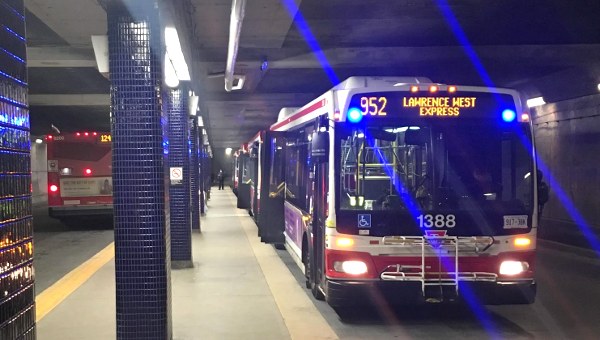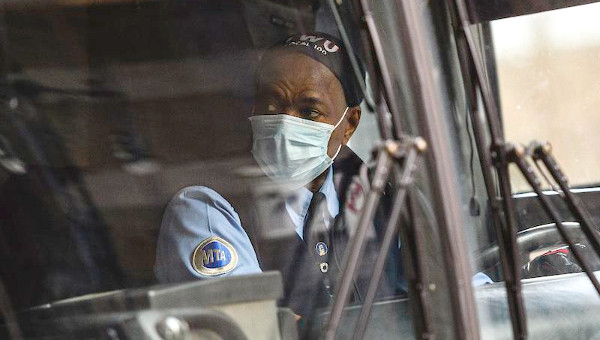When They Say Jump: The ATU and the TTC
On Thursday, December 17, Amalgamated Transit Union (ATU Local 113), the union that represents the majority of Toronto Transit Commission (TTC) workers, provided an example of how not to organize its membership for a job action.
At 7:30pm, the evening before the action was meant to take place, members received a vague text from the union’s president. It urged bus, transit and subway operators to briefly stop work for 4 minutes and 30 seconds “in honor of Transit Worker Assault Awareness Day.” That same evening, a short announcement about this planned work stoppage was also made at the General Membership meeting. However, for most workers, the mass text was the only communication they received.

This action was intended to be part of a broader health and safety campaign, which was launched recently following the stabbing of a member who works as a fare collector. The union had previously sent a mass text encouraging collectors to stay in their booths and the union president has been on AM radio advocating for City Council to recognize “Transit Worker Assault Awareness Day.”
Reports from the operators I spoke with following the scheduled action indicate that participation was sporadic at best. Some said no one during their shift participated, others said that they were the only one to join in. In one case an operator I spoke with estimated that roughly 20-50 of the 900 bus and subway operators in their division participated. Where I work in maintenance, there was no discussion and no participation in the action. ATU is an operator-dominated union and we clearly weren’t the target of the text.
The Need For Preparing Before Actions
The sentiment behind this work stoppage is good, and I am encouraged that there is an appetite within the union for pushing back on the job – one which extends beyond Friday’s events. For example, since the COVID pandemic began, operators have refused work over health and safety issues and there is a history of wildcat striking by Local 113’s members.
However, a meaningful work stoppage won’t result from a mass text message or an announcement. The kind of worker militancy that can hold up service across the TTC will only come through putting in the work of good organizing. This means having many one-on-one conversations with coworkers, until everyone is agitated like hell about the issue, knows the risks, and is choosing to act, prepared to meet the consequences.
In my experience, workers will not take on the risks associated with job actions unless they are united with enough of their coworkers to believe they will not be targeted individually for retaliation and that their action will have the impact they want. As one bus operator I spoke with said, “mass texting could be a tool, but it really should be the last part of mobilization, not a starting point.”
Furthermore, members know that the risks are not diminished simply because they have been encouraged to participate in a job action by union leadership. A worker might be worried about getting fired, or losing favor with their boss and the resulting perks of that curried favor. Workers participate in job actions because they are deeply invested in the issues at stake and believe both that they can win and that they can counter any repressive attempts by the employer to counter-organize.
Leadership and Retaliation
This failed action at the TTC is further evidence that union members won’t just blindly follow leadership, even if what that the leadership (socialist or otherwise) is seeking to do is ultimately good. The current Local 113 present, Carlos Santos, was elected on a “change” mandate and spoke of the need for worker militancy to push back against privatization efforts. Too often the prescription for union renewal is a call for electing a new leadership that wants to build a fighting union, but true substantial change cannot come from the top.
A more competent and unified Local executive probably would have been able to direct workers to action more effectively. If Local 113 shop stewards had communicated with workers in the weeks leading up to the “stop and stay” action and board members had shown up the day of, to bolster workers’ confidence that the union is supportive and will act to protect them, I imagine more workers would have participated. But what if workers had started to face real consequences for their participation? Can union leadership adequately protect workers engaging in work stoppages?
A union’s willingness and ability to protect members from retaliation is limited by their status as legal entities constrained by labour law. Concerted worker activity at the TTC in particular has been made completely illegal by two pieces of legislation: the Labour Relations Act (LRA) and more recently, Bill 150. In Ontario, the LRA defines a strike as
“a cessation of work, a refusal to work or to continue to work by employees in combination or in concert or in accordance with a common understanding, or a slow-down or other concerted activity on the part of employees designed to restrict or limit output.”
Strikes as defined are prohibited by the Act during the length of any collective agreement. If the employer violates a term of the collective agreement, the union can grieve this violation through the process outlined in the agreement, and if a worker feels work is unsafe, the union will help the worker individually exercise their right to refuse unsafe work, in accordance with the Ontario Occupational Health and Safety Act. Often the issues involved in grievances and work refusals are settled before proceeding to grievance arbitration or to the Labour Relations Board. However, if the process is followed through to the end, an adjudicator will have to assess the merits of the case by applying the law to the given facts of each case, and the union’s ability to obtain the remedy it seeks is dependent on this analysis. If the union loses, its only recourse is to apply for a reconsideration or a judicial review of the decision.
But what if the membership acts outside the confines of the law in order to achieve justice at work? What happens if union members, seeking to fight back on the job instead of through legal channels, go on strike? The penalties for violating the provisions of the LRA are up to $2,000 a day for individuals and $25,000 a day for the union (or the employer, for example in the case of a lockout). Accordingly, there is immense financial pressure for unions and individuals to capitulate in such situations. For example, in 2006, 800 maintenance workers at the TTC walked off the job over reassignment of day shift workers to night shift, and the government issued a cease-and-desist order to the union. The union, threatened by the possibility of paying $3 million in fines, eventually decided to break up the picket lines (the lawsuit was dropped in 2007).
Bill 150, provincial legislation passed by the former Liberal government in 2011, specifically revoked Local 113’s remaining legal right to strike by designating the TTC an essential service. The Bill extends the same prohibition and penalties for “striking” during the length of a contract as defined by the LRA to the collective bargaining process. Essential service legislation further entrenches the legalistic approach of unions to the defense of their members. Whereas before ATU 113 could legally exercise leverage on the job under specific situations, now they are held to forced arbitration in bargaining a contract. This is a continuation of the decades-long shift away from organizing on the floor to settling disputes via legalistic means.
It is no wonder why legislators stepped in to create the current legislative regime under which TTC workers currently labour. These workers, if organized, possess immense power – should transit workers decide to stop work, Toronto and practically the whole city’s economy would shut down. It has served the interests of capital well to limit the application of the most effective leverage transit workers have. The massive fines individual workers face for engaging in illegal work stoppages increase the risks of doing so. And yet, in order to leverage their full power, workers have no choice but to do exactly that.
Concerted Action
Engaging in concerted activity on the job in an organized way is the only thing that has the potential to win massive gains for transit workers. And the risk involved is not one that can be mitigated by a legal strategy. Legal efforts will not protect these workers from retaliation; it can only be offset by the further application of leverage on the job. That’s the only thing that ultimately makes the government and employers settle on terms favorable to workers.
The current legislative landscape means that workers must be smart about how they choose to exercise the leverage of collective action, but there is a space for them to challenge the employer at the shop level and win some victories without triggering the repressive legal framework until a time when they are ready to meet it willingly. Escalating from smaller fights with smaller-risk actions like “a march on the boss” also builds the confidence, militancy and organization that is required to overcome the pressure to divert militancy into proper legal processes when taking on larger fights and larger actions.
Wildcat striking without building the capacity of participants to make decisions collectively, and without having a plan for what to do next, will ultimately end in a quick return to work and the redirection of the struggle into a legal process. The facts of the TTC wildcat strikes are hard to pin down given the private nature of union-employer negotiation and settlement. But from the examples I have heard, the lack of an escalation plan and the sudden surge in wildcat militancy without doing the groundwork allowed these efforts to be quashed. The union, taken by surprise, usually intervenes to divert workers back to work and back into the appropriate legal channels. Typically the union settles with the employer before a court decision and sometimes before a hearing even occurs.
What Is the Role of the Union?
A union may be more or less supportive of rank-and-file initiative. The union may legally have to be publicly outspoken against worker militancy, but within the union they can do the bare minimum to dissuade workers from engaging in independent job action. But the quality of support offered usually depends less on the personal inclinations of union executives and more on the amount of support such initiatives have among the members.
Regardless, this legislative landscape means that even well-intentioned union leadership cannot protect the membership from legal repercussions just because they support worker action. Only the workers themselves can do that. A union leadership that is ideologically supportive of worker action is still not as important as the actual ability of workers to escalate and hold the line.
If anything, union leadership should foster a culture of disciplined, bottom-up worker initiative while trying to deflect the legal problems that come with shop floor militancy. But that’s a very different kind of leadership than the usual prescription of elected socialist officials who believe in a “fighting union.” Workers can’t be ordered blindly to the battlefront, only they themselves can collectively organize to fight. •
This article first published on the Organizing Work website.





